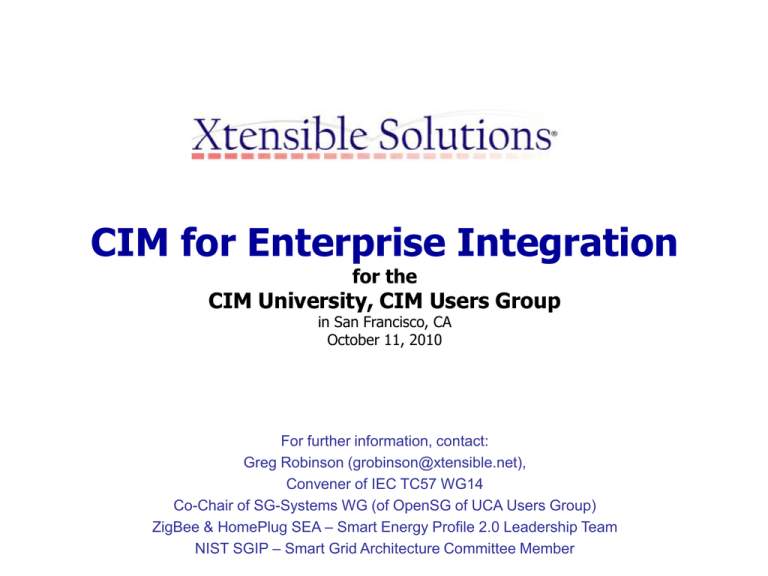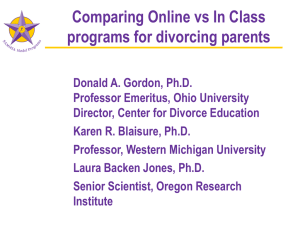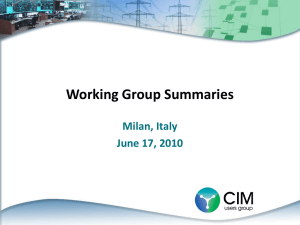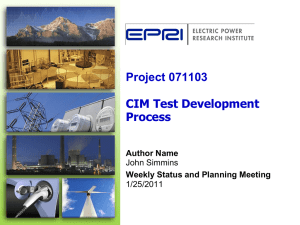CIM for Enterprise Integration - IEC 61968 Series - CIMug
advertisement

CIM for Enterprise Integration for the CIM University, CIM Users Group in San Francisco, CA October 11, 2010 For further information, contact: Greg Robinson (grobinson@xtensible.net), Convener of IEC TC57 WG14 Co-Chair of SG-Systems WG (of OpenSG of UCA Users Group) ZigBee & HomePlug SEA – Smart Energy Profile 2.0 Leadership Team NIST SGIP – Smart Grid Architecture Committee Member Agenda • CIM for enterprise integration (IEC 61968) – Overall Scope, Approach – Messaging – Highlights for Using CIM • AMI, DMS, OMS, GIS, CIS • Asset management, work management – Supporting the smart grid CIM Users Group: CIM for Enterprise Integration Slide 2 This is Not a Good Practice For Wires Integration; It’s Not Good For Data Integration Either! Wires Integration Anarchy! CIM Users Group: CIM for Enterprise Integration Slide 3 Goal: Interface Standards Should Be Based on Common Semantics (e.g., CIM) to Avoid Adding to ‘Integration Anarchy’ OMS GIS CIS DMS AMR Integration Infrastructure WMS Data Integration Anarchy! Integration anarchy is a chaos of: (1) (2) (3) (4) (5) Without duplicated logic, Common Semantics, duplicated data, Point-to-Point duplicated effort, Integration Will newly acquired integration difficulties, Continue at the Data Level lack of ability to easily create new application functionality from services, and (6) lack of ability to support business processes with applications Integration anarchy will result in higher costs and an inflexible, brittle Smart Grid Slide 4 System of Systems CIM Users Group: CIM for Enterprise Integration The IEC 61968-1 Interface Reference Model (IRM) Provides The Framework For Identifying Information Exchange Requirements Among Utility Business Functions Maintenance and Construction (MC) – IEC 61968-6 IEC 61968 Sequence Diagrams are organized by the IRM Network Operations (NO) – IEC 61968-3 Records & Asset Management (AM) – IEC 61968-4 Maintenance & Inspection (MAI) Operational Planning & Optimization (OP) – IEC 61968-5 Construction WMS (CON) Network Operations Monitoring (NMON) Operation Statistics & Reporting (OST) Substation & Network Inventory (EINV) Network Control (CTL) Network Calculations - Real Time (CLC) Geographical Inventory (GINV) Network Operation Simulation (SIM) Design & Estimate (DGN) Fault Management (FLT) Dispatcher Training (TRN) General inventory management (GIM) Switch Action Scheduling (SSC) Scheduling & Dispatch (SCH) Asset Investment Planning (AIP) Power Import Sched. & Optimization (IMP) Field Recording (FRD) Operational Feedback Analysis (OFA) Application Integration Infrastructure Network Extension Planning (NE) – IEC 61968-7 Customer Support (CS) – IEC 61968-8 Network Calculations (NCLC) Customer Service (CSRV) Project Definition (PRJ) Trouble Call Management (TCM) Construction Supervision (CSP) Point Of Sale (POS) Compliance Management (CMPL) External to DMS (EXT) Meter Reading & Control (MR) – IEC 61968-9 Meter Reading (RMR) Meter Data Management IMDM) Energy Trading (ET) Customer Account Management (ACT) Advanced Metering Infrastructure (AMI) Metering System (MS) Retail (RET) Financial (FIN) Demand Response (DR) Meter Maintenance (MM) Sales (SAL) Business Planning & Reporting (BPR) Load Control (LDC) Meter Data (MD) Stakeholder Planning & Management (SPM) Premises (PRM) Supply Chain & Logistics (SC) Human Resources (HR) Meter Operations (MOP) CIM Users Group: CIM for Enterprise Integration Slide 5 Key Concept: Incremental Integration - in Step With Business Needs GIS OMS CIS OR TT IEC 61968 IRM Interface Semantically Consistent ESB AMR WMS DMS Information Flow Design Trouble Ticket Outage Record CIM Users Group: CIM for Enterprise Integration DMS OMS CIS TT OR Slide 6 Key Concept: Replace Large Monolithic Applications ‘a Chunk at a Time’ Other Apps Other Apps Other Apps Field Recording Maintenance & Inspection Construction Work Scheduling Design CIM Message Types WMS CIM Users Group: CIM for Enterprise Integration Slide 7 Agenda • CIM for enterprise integration (IEC 61968) – Overall Scope, Approach – Messaging – Highlights for Using CIM • AMI, DMS, OMS, GIS, CIS • Asset management, work management – Supporting the smart grid CIM Users Group: CIM for Enterprise Integration Slide 8 IEC 61968 Basic Message Structure • A verb to identify the type of action being taken • A noun, to identify the type of the payload • The payload, which contains the data relevant to the information exchange as defined using a profile [source: IEC 61968-1] CIM Users Group: CIM for Enterprise Integration Slide 9 Message Header Field Description Verb This enumerated list of verbs can be used to form message types in compliance with the IEC 61968 standard Noun The Noun identifies the main subject of the message type, typically a real world object defined as a profile using the CIM. Revision Revision level of the message type. Context Intended context for information usage such as production, testing and etc. Timestamp Application level relevant time and date for when this instance of the message type was produced. This is not intended to be used by middleware for message management. Source Source person or system that publishes the message AsyncReplyFlag Indicates whether or not reply should be asynchronous ReplyAddress Address to be used for asynchronous replies AckRequired Indicates whether or not an acknowledgement is required User User information of the sender MessageID Unique message ID to be used for tracking messages CorrelationID ID to be used by applications for correlating replies Comment Optional comment Property Message properties can be used to identify information needed for extended routing and filtering capabilities. [source: IEC 61968-1] CIM Users Group: CIM for Enterprise Integration Slide 10 Message Types Are Created By Combining IEC 61968 Verbs With Information Exchange Topics, Referred To As Nouns Verbs Meaning CREATE The CREATE verb is used to publish a request to the master system to create a new document. CHANGE The CHANGE verb is used to publish a request to the master system to make a change in the document based on the information in the message. The CANCEL verb is used to publish a request to the master system to cancel the document. The CANCEL verb is used when the business content of the document is no longer valid due to error(s). The CLOSE verb is used to publish a request to the master system to close the document. The CLOSE verb is used when the business document reaches the end of its life cycle due to successful completion of a business process. The DELETE verb is used to publish a request to the master system to delete the document. The DELETE verb is used when the business document should no longer be kept in the integrated systems either due to error(s) or due to archiving needs. The GET verb is used to publish a request to the master system to get the current data for a given document reference code or a set of documents. CANCEL CLOSE DELETE GET Message Body All sections (data required to create the document) All sections (key(s) + data to be changed) Header information + message content key(s) Header information + message content key(s) Header information + message content key(s) One or more document reference codes + Key(s) [source: IEC 61968-1] CIM Users Group: CIM for Enterprise Integration Slide 11 Verbs CREATED CHANGED CLOSED CANCELED SHOW REPLY SUBSCRIBE UNSUBSCRIB E Meaning The CREATED verb is used to publish the creation of a document as a result of either an external request or an internal action within the master system of that document. The CHANGED verb is used to publish the change of a document as a result of either an external request or an internal action within the master system of that document. The CLOSED verb is used to publish the normal closure of a document as a result of either an external request or an internal action within the master system of that document. The CANCELED verb is used to publish the cancellation of a document as a result of either an external request or an internal action within the master system of that document. The SHOW verb is used to publish the most current content of a document as a result of either an external GET request or an internal action within the master system of that document. The REPLY verb is used to publish the processing result of an external request to the master system to create, change, delete, cancel, or close a document. The REPLY message type could contain specific confirmation information as to whether the request is processed successfully or not and provide alternatives if applicable. The SUBSCRIBE verb is used to publish the request to ask the master system of a document to publish a CHANGED document whenever there is a change to the document. The UNSUBSCRIBE verb is used to publish the request to ask the master system of a document to stop publishing a CHANGED document whenever there is a change to the document. Message Body All sections All sections (key(s) + changed content) Header information + message content key(s) Header information + message content key(s) (IEC 61968 Verbs - continued) All sections Header information + message content key(s) + confirmation information + alternatives (optional) Header information + message content key(s) Header information + message content key(s) CIM Users Group: CIM for Enterprise Integration [source: IEC 61968-1] Slide 12 Example of a “message type” payload [source: IEC 61968-1] CIM Users Group: CIM for Enterprise Integration Slide 13 Example of how message elements are derived from the CIM class part9: MeterReadings message type I dent ifiedObject + ServiceDeliveryPoint Metering:: ServiceDeliveryPoint 0..1 Agreement + CustomerAgreement Customers:: 0..1 CustomerAgreement + MeterReadings I dent ifiedObject 0..* Metering:: MeterReading + MeterReadings Act ivit y Record + EndDeviceEvents Metering:: 0..* EndDeviceEvent 0..* + MeterReading 0..1 + MeterReadings 0..* + MeterReading 0..1 EndDeviceAsset 0..1 + IntervalBlocks 0..* + MeterReadings 0..* Metering:: MeterAsset + MeterAsset Metering:: IntervalBlock + Readings 0..* Measurement Value Metering::Reading [source: IEC 61968-1] CIM Users Group: CIM for Enterprise Integration Slide 14 Navigating associations in CIM (UML notation) class part9: MeterReadings message type I dent ifiedObject Metering:: MeterReading + IntervalReadings Measurement Value 0..* + MeterReading 0..1 Metering:: IntervalBlock + IntervalBlocks 0..* 0..* + Pending 0..* + IntervalBlocks 0..1 Metering:: Pending + Pending I dent ifiedObject Metering:: ReadingType + IntervalReading 1 + IntervalBlocks + IntervalBlocks 0..* Metering:: IntervalReading 0..1 + ReadingQualities 0..* Metering:: ReadingQuality + ReadingType 1 + ReadingType 1 CIM Users Group: CIM for Enterprise Integration Slide 15 Navigating associations in message type schemas CIM Users Group: CIM for Enterprise Integration Slide 16 Agenda • CIM for enterprise integration (IEC 61968) – Overall Scope, Approach – Messaging – Highlights for Using CIM • AMI, DMS, OMS, GIS, CIS • Asset management, work management – Supporting the smart grid CIM Users Group: CIM for Enterprise Integration Slide 17 Case Study: LIPA Asset Management and Organization Asset Owner Responsibilities: (source: IEEE 2009) Asset Manager • Asset Optimization • Asset yield contribution understanding • Financial structuring • Business development • Asset specifications & standards • Full lifecycle asset management • Asset data management • Workload management • Asset financial and operating performance analysis • Asset strategy & plan development • Asset full lifecycle financial & operational data analysis • Regulatory strategy & negotiation • Contract management • Risk management • Asset data requirements definition • Asset opportunity development & analysis • Industry Best Practices • • • • • • • • Asset valuation Investment analysis & strategy Contract negotiation/structuring Regulatory oversight Market & economic analysis Portfolio management Capital allocation Asset financial & operating performance analysis • Asset planning • Asset acquisition & monetization Service Provider Responsibilities: • Construction & maintenance project management • Materials sourcing & inventory management • System engineering & design • Bargaining unit negotiations • Workforce scheduling & deployment • Work practice design & development • Asset data input and collection • Workforce training • Marketing & sales of services • Competitor analysis CIM Users Group: CIM for Enterprise Integration Slide 18 Case Study: LIPA Asset Management Concept (source: IEEE 2009) MSA Asset Management AssetManagement Management Asset Owner Customer Satisfaction Risk Management Strategy Plan Exe cute Data and Process Integration – CIM/IB/SOA Financial Technical Performance Impl ement Service Provider Risk RiskAssessment Assessment Risk Status Risk Drivers Risk Tolerance Assess Effectiveness LIPA LIPA Goals Goals Asset Manager Regulatory Assets & Processes (O&M&Planning) aspects KPIs Visualization Dynamic Criticality FMEA CIM Users Group: CIM for Enterprise Integration KRIs/Risk Indicators Slide 19 Some Foundational Relationships of the IEC CIM for Asset Management Document Organisation Information Containers Such As Asset Catalogues, Trouble Tickets, Work Orders, etc. Entities Performing One or More Roles Such As Customer, Supplier, Manufacturer, Service Provider, etc. Location Erp Person A Street Address, Coordinates For a Geographic or Schematic reference system, etc. A Person Performing Roles Such Dispatcher, Field Operator, etc. Power System Resource Activity Record Electrical Network Role Used For Planning, Operations, etc. Used to Record Each State change of CIM objects Type Asset Asset Model Asset Compatible Unit For Design & Procurement Particular Model and Version of a Vendor's Product Physical Plant Filling A Role Such As A Transformer, Pole, etc. CIM Users Group: CIM for Enterprise Integration Slide 20 IEC 61968-4: Records and Asset Management (Note: Maintenance Update in Process) • Network Data Set – Contains data for any part of a distribution network: • • • • • Typically selected for operational or extension planning studies Used in numerous implementations for GIS to DMS integration Can be part of a feeder, a single feeder or more than one feeder Can be either the ‘As built’ network or a proposed network selected for analysis It is a superset of IEC 61968-13 CDPSM (i.e., Distribution’s CPSM) – Contains references to other static data such as: • • • • • Elements of a TypeAssetCatalogue Elements of a AssetCatalogue Assets performing the roles of the associated types of PowerSystemResources Other “leaf node” elements such as Organisations, Locations, and Measurements Change Set – Contains updates required in a transaction for an existing NetworkDataSet – Each step in the ChangeSet is described through a separate ChangeItem. • A change item identifies the change type (add, delete, modify) • Sequence number for a particular change within a set of changes of a ChangeSet. – Only the identifiers of the relevant NetworkDataSet messages are to be included in a ChageSet message. • The actual contents are provided in accompanying NetworkDataSets messages. CIM Users Group: CIM for Enterprise Integration Slide 21 From the logical view to the physical asset view of the same object. PowerSystemResource (from Core) Organisation 0..n (from TopLevel) 0..n OrgPsrRole 0..n 0..n (from AssetBasics) 1..n DocPsrRole OrgAssetRole (from AssetBasics) (from AssetBasics) AssetPsrRole (f rom AssetBasics) ErpInventory (from ERP_Support) 0..1 +Documents 0..n DocAssetRole 0..n 0..n 0..1 (from AssetBasics) 0..n Document Asset 0..n (from DocumentInheritance) (from AssetBasics) 0..1 0..1 AssetModel (from AssetBasics) 0..n 0..1 TypeAsset FinancialProperties (from TypeAsset) (from AssetBasics) CIM Users Group: CIM for Enterprise Integration Slide 22 IEC 61968-4: Records and Asset Management (Note: Maintenance Update in Process) • Presentation: – Can contain location information for most any element represented in the CIM, particularly elements of the distribution network. – Provides location information of individual assets or power system resources – Provides a set of location information as a companion to the NetworkDataSet. • Asset List: – Can contain various amounts of data for any set of utility assets – Contains references to static reference data such as: • Elements of an AssetCatalogue • Elements of a TypeAssetCatlogue • PowerSystemResources that specify the role in which the Asset is being used – If it has been installed rather than sitting in inventory • Other “leaf node” elements such as Organisations, Locations, and Measurements CIM Users Group: CIM for Enterprise Integration Slide 23 Case Study: Asset Management System Used to Initialize System Control Center System (source: DistribuTECH2002) Asset Management Asset data sent in XML Adapter Transformation into CIM Objects Publish AMS data in CIM format Integration Bus Adapter Subscribe to Asset data System Control Center [presented at DistribuTECH 2001] CIM Users Group: CIM for Enterprise Integration Slide 24 Case Study: Operations Model Capabilities (source: DistribuTECH2002) AMS DMS CIM Users Group: CIM for Enterprise Integration Slide 25 PowerSystemResource (from Core) 0..n DocPsrRole (from AssetBasics) DocAssetRole (from AssetBasics) 0..n Document AssetListRole Asset 0..n 0..n (from AssetBasics) (from AssetBasics) (from DocumentInheritance) 0..n 0..n Collecti on Specification 0..n (f rom AssetBasics) (from Collections) 0..n AssetList (f rom AssetBasics) TypeAssetCatalogue AssetCatalogue (from AssetBasics) (from AssetBasics) 1 0..1 0..n AssetModel 0..n (from AssetBasics) 0..1 TypeAsset (from TypeAsset) 0..n 0..1 AssetCatalogueItem 0..n CIM Users Group: CIM for Enterprise Integration (f rom AssetBasics) Slide 26 IEC 61968-4: Records and Asset Management (Note: Maintenance Update in Process) • Asset Catalogue: – A collection of information regarding available types of products and materials that are used to build or install an Asset(s), to maintain an Asset(s) or to operate an Asset(s). – Each catagoue item is for a specific product available from a specific supplier. – Contains references to static reference data such as: • Elements of a TypeAssetCatalogue • Specifications • Other “leaf node” elements such as Organisations • Type Asset Catalogue – Contains data for a set of utility asset types – It is a collection of information regarding generic types of assets that may be used for design purposes, analysis, and so on – A TypeAsset is not associated with a particular manufacturer – Contains references to other Documents containing static reference data such as: • Elements of an AssetCatalogue • Other “leaf node” elements such as Organisation CIM Users Group: CIM for Enterprise Integration Slide 27 IEC 61968-6: Maintenance & Construction (Note: CD in development – paper being presented at Grid InterOp) Maintenance and Construction (MC) – IEC 61968-6 Maintenance & Inspection (MAI) Construction WMS (CON) Design & Estimate (DGN) Business Functions Performed • • • • Maintain and Plan PM Programs Manage Inspection and Maintenance “Triggers” Link Inspection orders to follow-up repair orders Gather “failure” data • • • • Initiate and Plan work orders Manage material, equipment, and permit requests Manage and Track Work (Workflow) Close Work and Support Performance Analysis • Work Design and Cost Estimation • Compatible Unit based Graphical design • Generate Bill of Materials Scheduling & Dispatch (SCH) • Assign crew based on work type and skills • Determine Schedule Date • Perform constraint-based “auto-scheduling” Field Recording (FRD) • Gather actual costs and support cost reconciliation • Monitor work progress • support financial closing with accounting systems CIM Users Group: CIM for Enterprise Integration Slide 28 IEC 61968-6: Maintenance & Construction • Work is created any time a person is required to perform an activity related to company assets. Examples of work include – Construction work (e.g. service installations, line extensions, and system betterment projects) – Service work (e.g meter replacements, Turn-on, Turnoff, etc.) – Maintenance work (e.g. routine oil changes, painting, etc.) – Inspection work (e.g. pole inspections, vault inspections, Substation inspections) – Trouble work (e.g. Power outage, voltage quality problem, etc.) CIM Users Group: CIM for Enterprise Integration Slide 29 IEC 61968-6: Construction & Maintenance • Current Message Types: – – – – – – – – – – – – – – Compatible Units Construction Work Crew Design Inspect & Test Labor One Call Request Procedure Service Work Trouble Work Work Cost Detail Work Scheduling Work Status Work Task CIM Users Group: CIM for Enterprise Integration Slide 30 Generic “TypeAssets” are used for Design CostType CUGroup (f rom WorkStandards) 0..1 0..n 0..1 (f rom WorkClosing) 0..n 0..1 0..n 0..n CompatibleUnit CUContractorItem 0..n (from WorkDesign) 0..n 0..n 0..n (f rom WorkStandards) 0..n 0..n 0..n 0..n Procedure (f rom WorkInspectionMaintenance) 0..n CUMaterialItem (f rom WorkStandards) 0..n 0..n 0..n CUAsset CUEquipmentItem (from WorkStandards) (from WorkStandards) CULaborItem (f rom WorkStandards) 0..n 0..1 0..1 TypeMaterial (f rom WorkStandards) 0..1 0..1 0..1 TypeAsset (from TypeAsset) CIM Users Group: CIM for Enterprise Integration Slide 31 IEC 61968-3: Network Operations (Note: Maintenance Update in Process) • Current Message Types: – Measurement list; – Operational restrictions; – Outage records; – Safety documents; – Switching schedules. • Regarding “Note”, currently being updated through a use case-driven and incremental maintenance cycle, with first iteration being in support of outage management. CIM Users Group: CIM for Enterprise Integration Slide 32 An Example: Safety Document Classes Organisation OrgErpPersonRole (from TopLevel) DocOrgRole (from TopLevel) (from TopLevel) 0..n 0..n 0..n 0..n SafetyDocument Document ErpPerson (from Operational) (from DocumentInheritance) (from ERP_Support) 0..n 0..n 0..n 0..n OperationalRestriction 0..n (from Operational) ActivityRecord (from ActivityRecords) 0..n PowerSystemResource (from Core) 0..n 0..1 ClearanceTag 1 (from Outage) 0..n ConductingEquipment Equipment PSRType (from Core) (from Core) (from Core) CIM Users Group: CIM for Enterprise Integration Slide 33 Safety Document Message Type CIM Users Group: CIM for Enterprise Integration Slide 34 IEC 61968-8: Customer Support (Note: Update to second CD in Process) • Current Message Types: – – – – – – – – – – – Trouble Ticket Failure Event Planned Outage Notification Call Back Compliance Event Outage History Service Extension Request ServiceRequest CustomerServiceAgreement Customer Billing Construction Billing CIM Users Group: CIM for Enterprise Integration Slide 35 Aspects of Customer Accounts Agreement CustomerAccount (from TopLevel) Equipment ConductingEquipment (f rom Core) (f rom Core) (from Consumers) 1..n 1 0..n 0..n 0..n 1 CustomerData CustomerAgreement (from Consumers) (from Consumers) 0..n 0..n ServiceLocation EnergyConsumer (from Locations) (f rom Wires) 1 0..1 0..n (f rom TopLev el) 0..n 0..1 0..n 0..n 1 0..n 0..1 Organisation 0..n 0..1 ErpPerson (f rom ERP_Support) ServiceKind SDPLocation (f rom Consumers) (from Locations) 0..n 0..n ServiceDeliveryPoint (from Metering) 0..n 1 0..n 0..n 0..n PricingStructure Tariff (from Consumers) 0..n 0..n PowerQualityPricing 1 (f rom Consumers) 0..n CIM Users Group: CIM for Enterprise Integration (f rom Consumers) 0..n Slide 36 A Customer Account Message Type for AMI (IEC 61968-9) CIM Users Group: CIM for Enterprise Integration Slide 37 IEC 61968-9 Reference Model Refer to Margaret’s presentation Agenda • CIM for enterprise integration (IEC 61968) – Overall Scope, Approach – Messaging – Highlights for Using CIM • AMI, DMS, OMS, GIS, CIS • Asset management, work management – Supporting the smart grid CIM Users Group: CIM for Enterprise Integration Slide 39 NIST Conceptual Model CIM Users Group: CIM for Enterprise Integration 40 [Source: NIST InterimSlide Roadmap] User groups are a good source of help Advisors Operating Officers Board of Directors Audit Committee Executive Committee Technical Publications Technical Oversight Committee Help Desk Marketing CIM Testing Liaison 61850 Harmonization Membership OpenSG http://www.ucaiug.org/ CIM Users Group: CIM for Enterprise Integration Slide 42 CIM Users Group: CIM for Enterprise Integration Slide 43 Key Collaboration Concept for the SG-Systems Working Group • Standard building blocks are defined by standards development organizations (SDOs) • Requirements (use cases) are gathered from helpful sources – Utilities – Industry initiatives • The SG-Systems WG articulates Industry Best Practices (see next slide) that satisfy requirements through the use of standard building blocks. – Recommended extensions and changes to standard building blocks are provided back to appropriate standards bodies. CIM Users Group: CIM for Enterprise Integration Slide 44 OpenSG Focus: Finding/Developing Best Practices & Making Them into Vetted “Industry Best Practices” Utility’s Projects - Design & • Local Utility Projects Implementations --------------- Utility’s Architecture ----------------------Industry Best Practices Interoperability Testing --------------------------------- Industry Best Practices -----------------------------------------Standards Conformance & Interoperability Testing • Consortiums & User Groups like OpenSG (business requirements) & CIMug (optimization & implementation support) • Standards Development Organizations (SDOs) like IEC TC57 Working Group 14 for the IEC 61968 series of standards, NAESB, IEEE, et al. (of UCAIug/OpenSG/SG-Systems WG) •The scope of AMI-ENT is the systems and/or applications within and around the utility enterprise and the inter-systems related business functions and stops at the boundaries of applications and the edge of utility enterprise. •The focus is on how these systems are to be integrated and composed to support AMI related business processes and functions. •Edge applications are those applications that communicate with networks and devices in the field, as well as those that Slide 46 CIM Users Group: CIM for Enterprise Integration communicate with other businesses or enterprises (generally defined as third parties). Case Study: Consumers Energy and AMI-Ent TF Customer Info. & Billing Outage Management Distribution Management Revenue Protection HAN Management AMI Service Manager Enterprise Bus + Common Model & Service AMIAMI-ENT Demand Response Management Customer Portal Third Party Portal Meter Data Management AMI Network Asset Management Meter Asset Management Representative of AMI-ENT components, not all inclusive. CIM Users Group: CIM for Enterprise Integration Slide 47 Case Study: AMI-Ent Service Identification CIM Users Group: CIM for Enterprise Integration Slide 48 Case Study: AMI-Ent Inventory of CIM-Based Services Supporting Use Cases for AMI-Enterprise Use Case & Integration Scenario Requirement Functional Description of Operation the Service Pattern Service Name Service Operation Service Provider Information Object (Inbound - WS) (normalized) CreatedMeterReading Service Consumer (Outbound) Head End B1-S1 REQ-B1004 MeterReading B1-S12 REQ-B1011 B1-S15 REQ-B1012 MDUS receives the meter Created reading results on scheduled basis.meter MDUS receives Created reads MDUS notifies meters with Created reading problems MDUS MeterReading MeterReading CreatedMeterReading Field Tool MDUS MeterReading MeterSystemEvent CreatedMeterSystemEvent MDUS? MDUS MeterSystemEvent B1-S15 REQ-B1013 MeterServiceOrder CreatedMeterServiceOrder MDUS Head End MeterServiceOrder REQ-B1014 AMI Head End operator Created receives meter service orders Request billing determinant Create B1-S17 BillingDeterminantRequest CreateBillingDeterminant CIS MDUS BillingDeterminant B1-S17 REQ-B1014 Request billing determinant Created BillingDeterminant CreatedBillingDeterminant MDUS CIS BillingDeterminant B1-S2 REQ-B1001 MeterReading CreateMeterReading TBD Head End MeterReading B1-S2 REQ-B1002 Head End receives the Create request for a meter reading on demand MDUS receives a meter Created reading on demand MeterReading CreatedMeterReading Head End MDUS MeterReading B1-S2 REQ-B1003 Created MeterReading CreatedMeterReading MDUS TBD MeterReading B1-S3 REQ-B1006 A user or system receives a meter reading on demand CIS receives meter event Created MeterSystemEvent CreatedMeterSystemEvent CIS MeterSystemEvent B1-S7 REQ-B1009 MDUS receives the request Create for meter readings MeterReading CreateMeterReading Head End/MDUS Third Party Portal MDUS MeterReading B1-S7 REQ-B1010 Third party receives the meter readings MeterReading CreatedMeterReading MDUS Third Party Portal MeterReading B1-S8 REQ-B1009 MDUS receives the request Create for meter readings MeterReading CreateMeterReading Third Party Portal MDUS B1-S8 REQ-B1010 Third party receives the meter readings Created MeterReading CreatedMeterReading MDUS Third Party Portal MeterReading B2-S1 REQ-B2001 Created ScheduledEvent CreatedScheduledEvent CIS Head End ScheduledEvent B2-S1 REQ-B2002 Created ConnectDisconnect CreatedConnectDisconnect CIS Head End ConnectDisconnect B2-S1 REQ-B2003 Send scheduled shut off notification Send scheduled shut off command Send scheduled shut off command confirmation Created CommonConfirmation CreatedCommonConfirmation Head End CIS CommonConfirmation B2-S1 REQ-B2004 Send meter read (final) Created MeterReading CreatedMeterReading Head End MDUS MeterReading B2-S2 REQ-B2005 Request AMI Meter status Create MeterStatusRequest CreateMeterStatus CIS Head End MeterStatus Created CIM Users Group: CIM for Enterprise Integration MeterReading Slide 49 Application View Services Provided/Consumed by “Customer Information Management” Service Operation CommonConfirmation MeterStatus HanAsset Created Created Created Service Operation CommonConfirmation MeterStatus MeterSystemEvent Meter Data Management Meter Data Management Created Created Created Created ScheduledEvent MeterStatus ConnectDisconnect Create ConnectDisconnect HANAsset MeterStatusRequest Create MeterStatusRequest LoadControlCommandRequest Create LoadControlCommandRequest HANAsset Create HANAsset AMI Head End AMI Head End BillingDeterminant ScheduledEvent BillingDeterminant MeterStatus ServiceToken Created Changed MeterSystemEvent BillingDeterminant MeterAssetRequest MeterServiceOrderRequest Create Change Create ServiceToken AMI Head End AMI Head End BillingDeterminant MeterAssetRequest MeterServiceOrderRequest Meter Data Management Meter Data Management Customer Information Management Customer Information Management Service Consumers Service Providers / Consumers CIM Users Group: CIM for Enterprise Integration Service Providers Slide 50 Technical View (Patterns) SendMeterReading Service Operations A Native API or Service T S/C Application A S/P ReceiveMeterReading CreatedMeterReading CreatedMeterReading ChangedMeterReading ChangedMeterReading CanceledMeterReading CanceledMeterReading Orchestration S/C Transparent ESB Guaranteed delivery within ESB, plus internal routing…… CIM Users Group: CIM for Enterprise Integration S/P T Native API or Service B Application B Other interested parties…… Slide 51 Common Concerns About The CIM for Integration – Concern 1: the CIM is too large • For the common systems language, the CIM can be thought of as the unabridged dictionary. It is important to note that projects only use the portion of the dictionary relevant to their implementation • But as the dictionary is is much richer, there will be consistency and congruity for other areas that the implementation must interface with. – Concern 2: the CIM inhibits innovation • Because people don’t have to waste time re-inventing things that have been well vetted in the community, they can leverage the existing dictionary while focusing more energy on their innovative concept. • Not only is this more efficient for the innovator, but it is also much more efficient for the people the innovators wants to share his ideas with. The community is already educated on how to use the well vetted language. – Concern 3: the CIM is too slow • This is like saying the English language is slow; it is based on the speakers command of the language and the choice of media used. • When a person communicates with someone, they must: 1. Articulate the information for the receiver to comprehend it 2. As a person may then provide this information through the US Postal Service, through email, through phone calls, etc., the system may provide this information over many types of middleware (messaging, file transfers, data base, etc.) [source: IEEE T&D Optimization Panel 2010] CIM Users Group: CIM for Enterprise Integration Slide 52 Common Concerns About The CIM for Integration (continued) – Concern 4: The CIM is too abstract • This quality enables the CIM to continue to be relevant and valid even as technology continuously changes. The ability to properly convey unambiguous information primarily boils down to one’s skills in applying the common systems language. – Concern 5: The CIM is not a best practice data model • For any individual purpose, one can always invent a model that is superior to any other existing model. • The CIM has not been developed for only one functional area, but rather by a wide range of domain experts for integrating disparate applications. So for inter-application integration purposes, a superior model does not exist and would be difficult to achieve. – Concern 6: The CIM is too hard to implement • Specialized models are often biased for a particular implementation and used with the a specific implementation technology. If the implementation never had to interface with other systems, this would be easier. • As the CIM is an information model that is technology neutral, using the CIM does require following a process that restricts the general information model for particular contexts and then generates the appropriate design artifacts. The CIM Community has been doing this for some time and many tools are available for automating the process. [source: IEEE T&D Optimization Panel 2010] CIM Users Group: CIM for Enterprise Integration Slide 53 Thank you for your time! • Good news: The CIM is being used extensively – so learning about it is time well spent. • Bad news: The CIM continues to need a lot of work and therefore users must be prepared for revision management • Fun news: The CIM is a key NIST standard – so we have many exciting adventures (HAN, DER, PEV, ADE, DR, etc.) to look forward too! CIM Users Group: CIM for Enterprise Integration Slide 54





